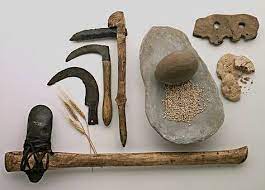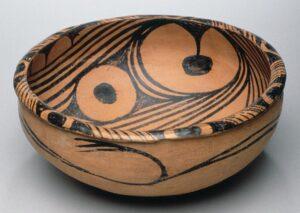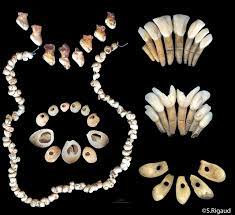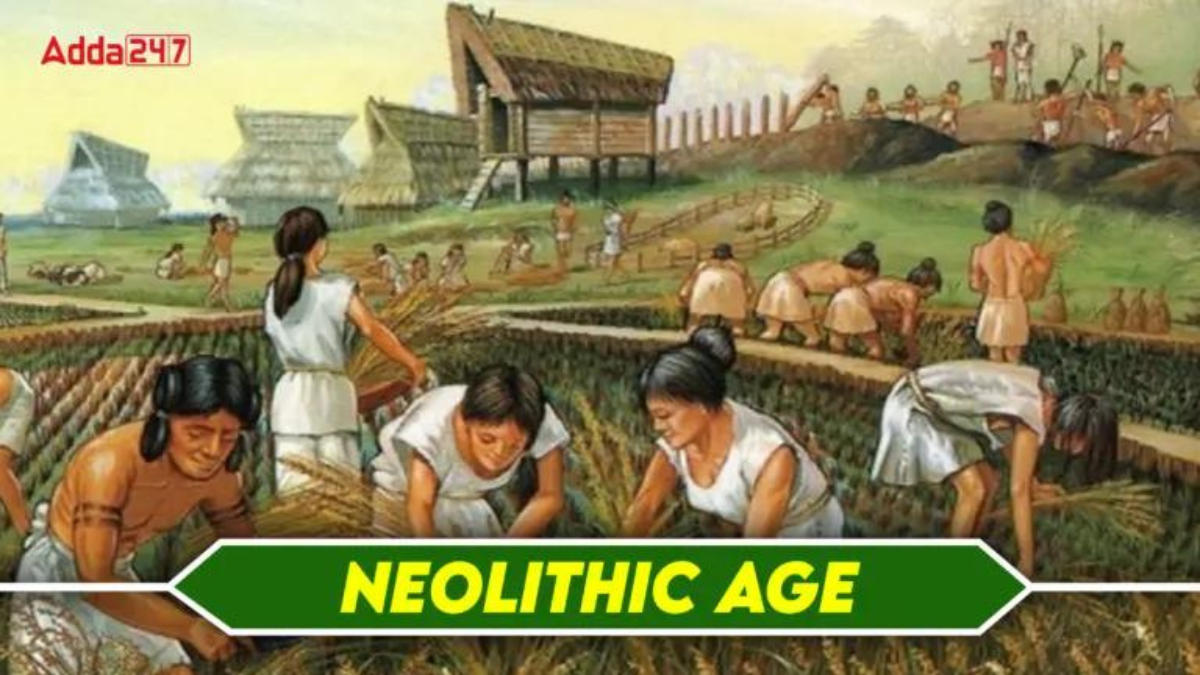Table of Contents
In 1865, Sir John Lubbock introduced the term ‘Neolithic Age’ to denote the New Stone Age. The transition to settled agriculture in the Indian subcontinent is attributed to Mehrgarh in Baluchistan, dating back to 7000 BCE, signifying the onset of the Neolithic era in India following the Mesolithic Age.
Candidates preparing for the UPSC IAS exam, especially in the History Optional, stand to benefit significantly from a comprehensive study of the Neolithic Age. As this period frequently appears in exam inquiries, aspirants should prioritize mastering this topic to excel during their tests.
Neolithic Age
The Neolithic Age, also known as the New Stone Age, marks a pivotal period in human history characterized by significant advancements in technology, social organization, and lifestyle. Beginning around 12,000 years ago, this era saw a transformative shift from nomadic hunter-gatherer societies to settled agricultural communities. Agriculture became the foundation of Neolithic life, as communities began to domesticate plants and animals for food.
This agricultural revolution not only provided a stable food supply but also led to population growth and the formation of permanent settlements. The Neolithic Age was also notable for the development of complex tools, pottery, and early forms of craftsmanship, which paved the way for specialized labor and the establishment of social hierarchies.
Additionally, the Neolithic era witnessed the emergence of symbolic expression through rituals, art, and communal structures, reflecting the increasing complexity of human societies. In essence, the Neolithic Age ushered in a new era of human progress, profoundly influencing the course of civilization for millennia to come.
Ancient Settlements During the Neolithic Era
In ancient times, people were hunter-gatherers, moving from place to place in search of food. However, in the Neolithic Age, some people in India chose to settle down and become the first farmers, marking the beginning of settled habitation.
- The earliest villages in India, like Mehrgarh and Bhirrana, emerged around 7000 years ago during the Neolithic Age.
- At Mehrgarh, people constructed their first homes using mud bricks and began cultivating wheat and barley in fields. They also domesticated animals and crafted pottery for storage.
- Mehrgarh remained a village for approximately 2000 years during the Neolithic Age.
- Similarly, in Bhirrana, villagers used mud bricks to build their homes and cultivated crops like wheat and barley while raising animals.
- These early villages illustrate the transition of ancient Indians into farmers and builders during the Neolithic Age.
- As these villages grew, inhabitants began engaging in new activities such as weaving cloth and making jewelry.
- The knowledge and skills developed in these early Neolithic villages laid the groundwork for the subsequent growth of the great Indus civilization.
- The establishment of villages in places like Mehrgarh and Bhirrana during the Neolithic Age marked a significant shift in Indian life, transforming society through agriculture and settled living.
Also Check: History Notes For UPSC
Neolithic Age Agriculture
During the Neolithic Age, people were mostly nomadic, moving around to find food. In India, some began to settle in one place and became the first farmers of the time. This shift marked the start of agriculture and the move from wandering to living in established communities.
- The earliest villages in India emerged around 7000 years ago during the Neolithic Age when people learned the techniques of crop cultivation.
- In places like Mehrgarh and Bhirrana, farmers cultivated wheat and barley, clearing land to create fields and utilizing stone tools such as hoes, digging sticks, and sickles.
- Farmers acquired various skills during the Neolithic Age, including seed selection, planting timing, and irrigation management.
- Animals played a crucial role in Neolithic farming, with oxen used to pull wooden ploughs and sheep and goats utilized for consuming leftover crop residues, their dung acting as fertilizer.
- Farming facilitated village growth by providing surplus food, allowing for increased survival rates among children and enabling the trade of excess crops for essential goods.
- However, early Neolithic farmers encountered challenges such as pest infestations and weed competition, prompting them to develop solutions like crop rotation.
- Agricultural advancements were gradual during the Neolithic Age, with millet and rice cultivation beginning around 5000 BCE in India, and the domestication of humped zebu cows for ploughing fields.
- The agricultural knowledge gained in Neolithic villages served as a foundation for later civilizations, eventually evolving into the cities of the Indus Valley Civilization.
Neolithic Tools
During the Neolithic Age, ancient Indians made significant advancements in tool making, crucial for farming, construction, and crafting.
- Around 7000 years ago, Neolithic people developed new types of tools, crafted from hard stones like dolerite and granite, including axes, adzes, chisels, sickles, and grinding stones.

- These stone tools revolutionized daily life during the Stone Age, with axes used for land clearing and timber cutting, adzes for shaping wood, chisels for decorative work, sickles for crop harvesting, and grinding stones for processing grains.
- Microlithic tools were also invented, comprising tiny stone blades affixed to wooden handles to create composite tools, such as spearheads, arrowheads, and sickles, utilized by early farmers.
- As Neolithic villages expanded, new tool varieties emerged, such as mud bricks for housing construction, pottery wheels for crafting storage vessels, and looms for weaving cloth.
- Despite advancements, stone remained the primary material for tools during the Stone Age, with copper and bronze not yet in use. However, villagers honed their stone-working skills, mastering techniques like abrasion and polish.
- Neolithic tools reflect innovations stemming from trial and error, with early farmers gradually improving blade efficiency, hand grips, and mounting systems over centuries, using tools like hammerstones and querns to shape stones.
- The technology of Neolithic tools disseminated to subsequent cultures, laying the groundwork for later developments in metallurgy, likely influenced by observations of metals in nature, while Neolithic techniques in stone shaping using fire contributed to early Bronze Age metalwork.
Pottery and Jewellery During Neolithic Age
During the Stone Age in India, people acquired the skill of crafting pots from clay and firing them in kilns. These clay vessels served various purposes within the household. Surahis, small pots, were utilized to store grains, water, oil, and other essentials. Handis, and bowls, were employed for cooking food. Additionally, screens were fashioned to separate grain husks, while flat dishes were crafted for serving food.
- Stone Age pottery in India featured simple decorations, with prevalent black and red pots. Black pots lacked oxygen during firing, while red pots had iron oxide added to the clay.
- Some pots displayed painted designs, including straight lines and triangles, while others had stamped patterns made with sticks and shells.

- Stone Age jewellery reflected social customs, often crafted from locally available materials like stone, shell, clay, and bone.
- Shell beads and stone beads of various shapes were common, along with metal jewellery made from copper and bronze.

- Clay jewellery, including beads, bangles, and pendants, was abundant, as were ornaments like finger rings and hairpins.
- These artefacts provide insights into Stone Age lifestyle, culture, and technological progress, showcasing the craftsmanship and aesthetic sense of ancient Indians.
Features of Neolithic Age
During the Stone Age, ancient India saw the rise of farming villages, each marked by distinctive social structures and cultural practices.
- Villages were built near water sources and had houses made of mud, brick, and wood, typically home to 10 to 100 families.
- Farming was central to village life, with crops like wheat, barley, millet, peas, cotton, and vegetables grown, and cattle and smaller animals raised.
- Stone Age villages also had specialized groups skilled in pottery, tool making, and early metalworking.
- Social organization likely revolved around clans and family lines, with elders and clan heads influencing decisions regarding religion, rituals, and social life.
- Villages probably had councils and chiefs to resolve disputes and manage communal resources, with social distinctions based on occupation, skills, and influence.
- Religious beliefs were significant, with evidence of female deity worship, nature worship, and rituals surrounding death, including simple burials with grave goods and ritual funeral practices.
- Ritual centres or sacred sites existed for ceremonies and festivals, involving animal sacrifices and rituals to seek divine favour.
- Stone Age culture flourished with art forms like paintings, sculptures, pottery designs, and personal adornments, showcasing creativity and aesthetic sensibility.
- Music and dance were integral to rituals and festivals, with musical instruments like flutes crafted from bird bones indicating musical development.
- Oral traditions preserved myths, legends, folk stories, and poems, forming an essential part of the Stone Age cultural heritage.
| Related Articles | |
| The Palaeolithic Age | |
| The Mesolithic Age | |
| The Chalcolithic Culture | |
| Advent of Aryans | |



 Bishnoi Movement - History, Objective, a...
Bishnoi Movement - History, Objective, a...
 Position of Women in Vedic Age: Societie...
Position of Women in Vedic Age: Societie...
 Bodhisattvas: History, List of Bodhisatt...
Bodhisattvas: History, List of Bodhisatt...
